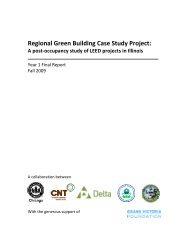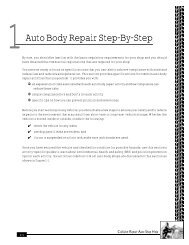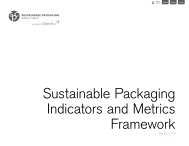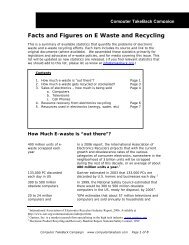CEA 2010 Sustainability Report - Consumer Electronics Association
CEA 2010 Sustainability Report - Consumer Electronics Association
CEA 2010 Sustainability Report - Consumer Electronics Association
Create successful ePaper yourself
Turn your PDF publications into a flip-book with our unique Google optimized e-Paper software.
Image source: http://www.apple.com/environment/<br />
E N V I RO N M E NTA L<br />
PERFORMANCE<br />
SUSTAINABLE<br />
PRODUCT DESIGN<br />
SUSTAINABLE<br />
PACKAGING DESIGN<br />
SUSTAINABLE<br />
FACILITIES<br />
Apple Communicates User-Friendly LCA Results to <strong>Consumer</strong>s<br />
Apple was the first in the industry to complete a comprehensive life cycle analysis for every product<br />
it ships to determine where its greenhouse gas (GHG) emissions came from. Apple discovered<br />
that 97 percent of the company’s footprint is directly associated with its products — from<br />
manufacturing to customer use to recycling — and only three percent from its facilities. That’s<br />
why Apple is focused on designing the next generations of products to use less material, ship with<br />
smaller packaging, be free of many toxic substances, and be as energy efficient and recyclable as<br />
possible. On “The Story Behind Apple’s Environmental Footprint” webpage, the company graphically<br />
depicts the life cycle of an Apple product and the relative impact each life cycle stage has on<br />
the environment. Environmental performance for individual products, including a breakdown of the<br />
GHG emissions for each stage of the lifecycle can be found in Apple’s Product Environmental <strong>Report</strong>s.<br />
SUSTAINABLE<br />
TRANSPORT<br />
& DELIVERY<br />
ENERGY<br />
EFFICIENCY<br />
ECYCLING<br />
The JIG Guide facilitates the reporting of material<br />
content information in electronics products<br />
across the global supply chain. This document sets<br />
minimum requirements for material declaration<br />
for electronic products based on the requirements<br />
of RoHS, REACH and other existing<br />
legislation, but does not preclude companies<br />
from inquiring about the presence of additional<br />
substances when necessary for their needs.<br />
Utilizing DfE tools like LCA and the JIG Guide<br />
enable CE companies to design more sustainable<br />
products that use environmentally preferable<br />
materials, fewer materials, and maximize reusability<br />
and recyclability at the end of the product’s life.<br />
The JIG Guide was developed by<br />
The <strong>Consumer</strong> <strong>Electronics</strong> <strong>Association</strong>,<br />
DIGITALEUROPE and the<br />
Japanese Green Procurement Survey<br />
Standardization Initiative.<br />
To view the guide, visit: CE.org/JIG<br />
Increasing Material Efficiency<br />
Many electronics manufacturers also are working<br />
to improve the material efficiency of their<br />
products. This is known as dematerialization,<br />
and results in products that consume fewer<br />
resources, require less energy to transport, and<br />
are easier to recycle at the end of life. Over the<br />
last few years, product weights have decreased<br />
dramatically in many product categories. The<br />
Washington Materials Management & Financing<br />
Authority (WMMFA) compiled data on average<br />
weights of electronics produced from 2008<br />
to <strong>2010</strong>, and found that generally, weights have<br />
decreased over time (see Figure 1). The outlier<br />
in the group — LCD monitors over 19 inches —<br />
has increased in weight since 2008 due to larger<br />
monitors becoming popular.<br />
SOCIAL<br />
PERFORMANCE<br />
SOCIAL<br />
CONTRIBUTIONS<br />
CORPORATE<br />
SUSTAINABILITY<br />
REPORTING<br />
CE A <strong>2010</strong><br />
SUSTAINABILIT Y<br />
REPORT<br />
11















